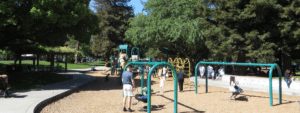Clark Mason
Cloverdale, the lone city in Sonoma County without an urban growth boundary, is set to finally put the boundary issue to voters, but not before a few questions get answered.
The City Council Wednesday will hold a public hearing on the proposed boundary and plan to place it on the November ballot.
“I’m pleased we are finally at the stage where we no longer argue about whether we need a UGB, but what kind we need,” Mayor Carol Russell said Tuesday. “It’s a great step forward. It brings us into the family of cities in Sonoma County.”
Urban growth boundaries are intended as a method for voters to control development on city fringes. They are seen as a way to limit sprawl, promote in-fill development and preserve areas that serve as separators between agriculture and developed land.
Once in place, they are set for 20 years and can only be changed by voters.
Russell was a strong advocate for a growth boundary in her campaign three years ago for City Council. She faced doubts from those who believed it was superfluous because of Cloverdale’s “natural boundaries,” essentially the hills to the west and the Russian River on the east.
“That’s been put to rest,” Russell said.
During the past couple years, in a number of workshops, planning and City Council hearings, the outlines of a growth boundary have emerged. But there are still questions, particularly whether city services should be extended almost two miles south to the small community of Asti.
Critics fear that extending services that far holds potential for sprawl, or creating the wrong type of development at the town’s southern gateway.
Both the Greenbelt Alliance and Sonoma County Conservation Action, an environmental advocacy group, have urged that the council not create an “exception area” for Asti that allows for city utilities to be extended there.
In the alternative, they suggest development at Asti be restricted and the size of a sewer line extension be limited to keep a lid on growth.
Others have raised concerns over extending city water that far south, noting the town of 8,600 residents plans to grow to 12,000 people, but has had to ration water in recent summers because of problems with its municipal wells.
Asti is the historic home of the Italian Swiss Colony winery. It is now owned by Foster Wine Estates, the Napa-based wine division of the Australian beverage giant, which produces Cellar 8 and other brands at Asti Winery.
In approving a new general plan last year, the City Council included Asti for future extension of city services. Council members said they wanted to be able to extend services and provide the winery the option to expand and create more jobs.
Three weeks ago, a divided Planning Commission voted 3-2 in favor of the urban growth boundary that would extend benefits to Asti. The dissenters approved the concept of a UGB, but had qualms about giving Asti special status, as well as concerns that the plan will allow some development on the western hillsides.
Community Development Bruce Kibby is recommending the City Council consider two options:
Allow “visitor commercial” uses at Asti, which could enable substantial new development there. Or, designate the surrounding vineyards for conservation, to remain in agricultural use, which would have the effect of limiting the area available for large commercial development.
Wednesday’s public hearing begins at 6:30 p.m. at the Cloverdale Senior Center, 311 N. Main St.
###
http://www.pressdemocrat.com/article/20100622/ARTICLES/100629856/1033/news?p=1&tc=pg




